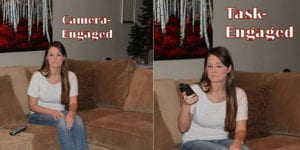 Thiessen, A., Beukelman, D., Hux, K., & Longenecker, M. (2016). A comparison of the visual attention patterns of people with aphasia and adults without neurological conditions for camera-engaged and task-engaged Visual Scenes. Journal of Speech, Language, and Hearing Research, 59, 290-301.
Thiessen, A., Beukelman, D., Hux, K., & Longenecker, M. (2016). A comparison of the visual attention patterns of people with aphasia and adults without neurological conditions for camera-engaged and task-engaged Visual Scenes. Journal of Speech, Language, and Hearing Research, 59, 290-301.
doi: 10.1044/2015_JSLHR-L-14-0115
Purpose: The purpose of the study was to compare the visual attention patterns of adults with aphasia and adults without neurological conditions when viewing visual scenes with 2 types of engagement.
Method: Eye-tracking technology was used to measure the visual attention patterns of 10 adults with aphasia and 10 adults without neurological conditions. Participants viewed camera-engaged (i.e., human figure facing camera) and task-engaged (i.e., human figure looking at and touching an object) visual scenes.
Results: Participants with aphasia responded to engagement cues by focusing on objects of interest more for task-engaged scenes than camera-engaged scenes; however, the difference in their responses to these scenes were not as pronounced as those observed in adults without neurological conditions. In addition, people with aphasia spent more time looking at background areas of interest and less time looking at person areas of interest for camera-engaged scenes than did control participants.
Conclusions: Results indicate people with aphasia visually attend to scenes differently than adults without neurological conditions. As a consequence, augmentative and alternative communication (AAC) facilitators may have different visual attention behaviors than the people with aphasia for whom they are constructing or selecting visual scenes. Further examination of the visual attention of people with aphasia may help optimize visual scene selection.
Acknowledgments: This project was supported in part by the Rehabilitation Engineering Research Center on Communication Enhancement (AAC-RERC) under Grants H133E080011 and H133E140026 from the National Institute on Disability and Rehabilitation Research (NIDRR) in the U.S. Department of Education’s Office of Special Education and Rehabilitative Services (OSERS). The project was also supported in part by Tobii Technologies. The authors wish to thank the residents and the staff at Quality Living, Inc. in Omaha, NE, for their participation in the research activities. The authors report no conflicts of interest and are solely responsible for the content and writing of the article.
